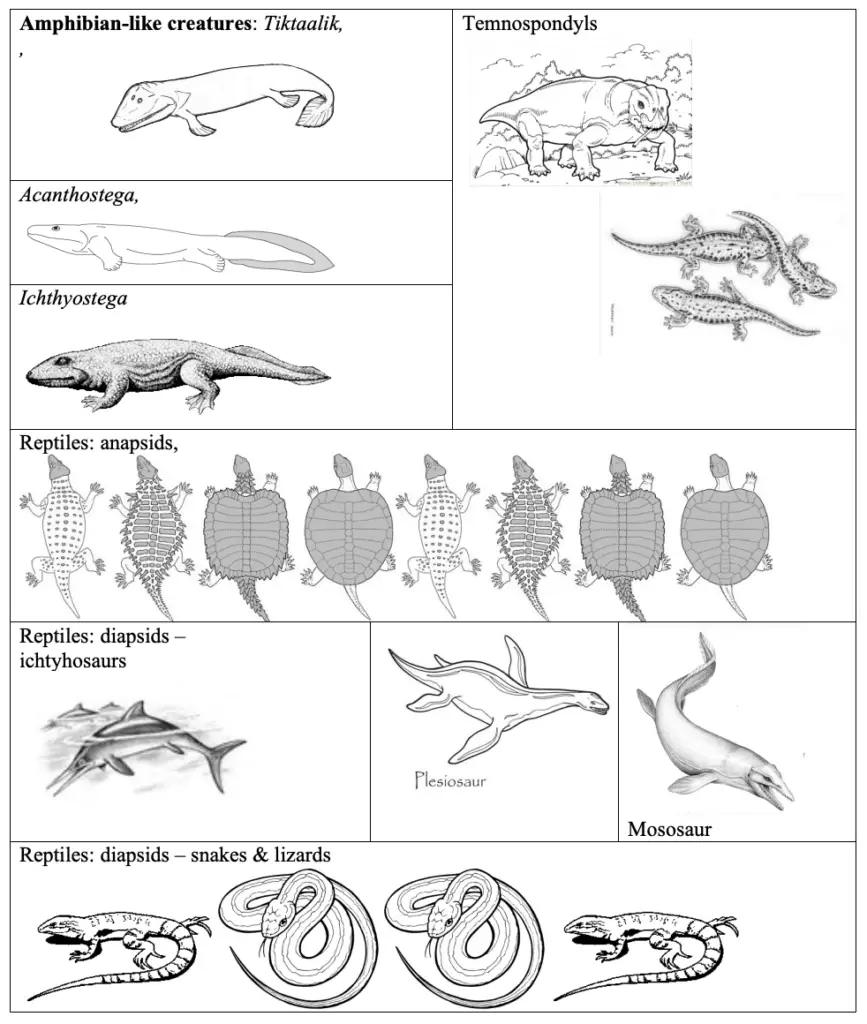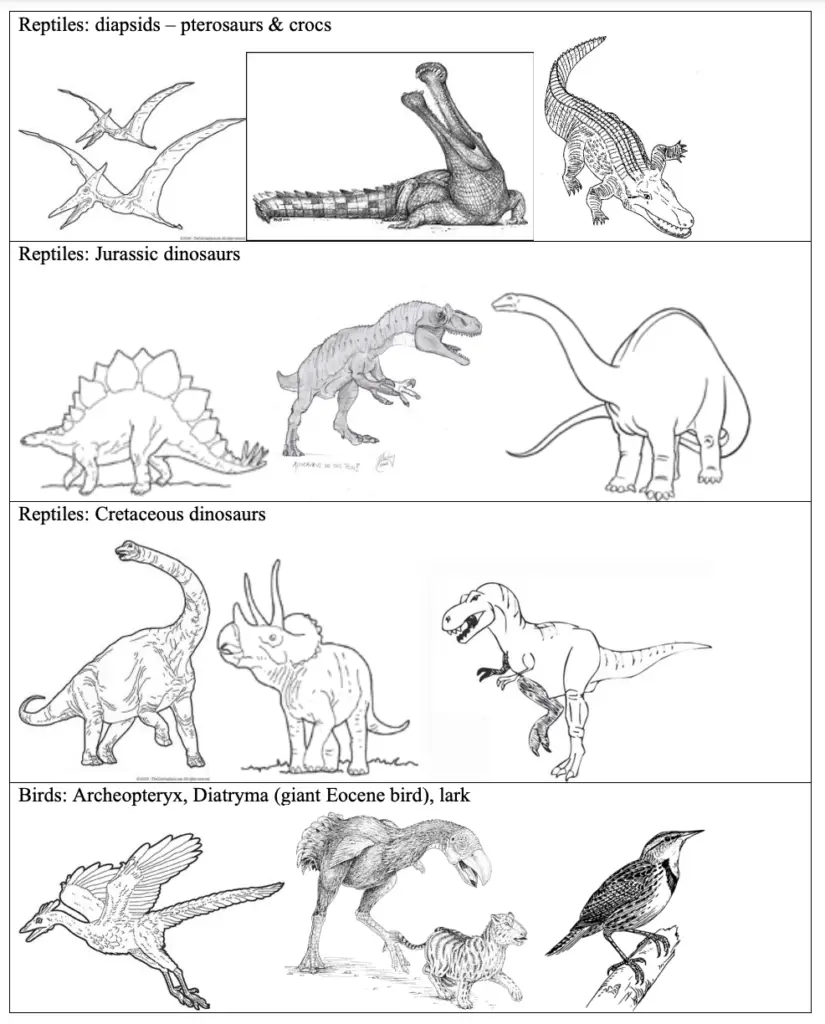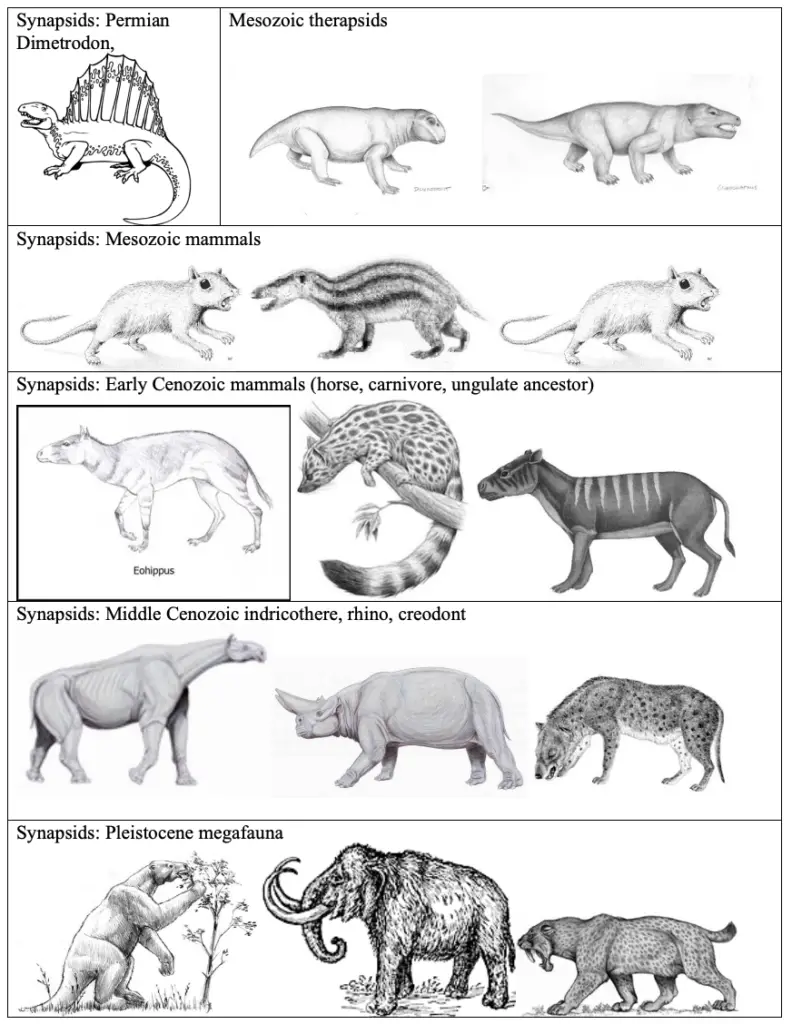Tetrapoda: Evolution from Fish to Land-Dwelling Vertebrates
Tetrapods are a group of vertebrates that includes amphibians, reptiles, birds, and mammals. The first tetrapods evolved during the Devonian period from crossopterygian fishes, which were adapted to shallow, marshy environments. These fishes already possessed some features that made their transition to land possible. The transition from aquatic to terrestrial life involved several anatomical changes. Below is a structured explanation of these evolutionary adaptations:
- Tetrapod Limbs:
- The first major adaptation was the development of tetrapod limbs. These limbs evolved to support the body in a terrestrial environment.
- Unlike fishes, whose fins primarily functioned for propulsion in water, tetrapod limbs needed to support the entire body weight on land.
- This change allowed the animals to move across muddy banks and eventually onto solid land surfaces.
- Loss of Gills and Development of Lungs:
- In the aquatic environment, fish used gills for respiration, extracting oxygen from water. However, as tetrapods adapted to terrestrial habitats, gills were gradually lost.
- Lungs became the primary organs for breathing, as air contains more oxygen than water, and lungs are more efficient at extracting oxygen from air.
- This shift in respiratory mechanisms was vital for survival on land.
- Transformation of the Hyomandibular Bone:
- The hyomandibular bone, which was part of the second visceral arch in fish, evolved into the columella (also known as the stapes) in tetrapods.
- The columella serves a crucial role in hearing by transmitting sound vibrations from the air to the inner ear, an adaptation that allowed tetrapods to detect sounds in the air, unlike their aquatic ancestors who primarily relied on vibrations in water.
- Loss of Scales and Cutaneous Respiration:
- As tetrapods moved to land, the scales of their fish ancestors were no longer necessary.
- The loss of scales allowed for cutaneous respiration, where oxygen is absorbed directly through the skin, especially in amphibians, which still spend significant time in aquatic environments.
- This adaptation helped compensate for the loss of gills in the adult stage.
- Skull and Vertebral Adaptations:
- The tetrapod skull evolved to better support head movement and improve visibility.
- Two occipital condyles developed, allowing the skull to move up and down on an atlas vertebra, a necessary modification for locomotion on land.
- The vertebral column also adapted for life on land. In fish, the vertebrae were amphicoelous, meaning both ends were concave, which was suitable for swimming. However, in tetrapods, the vertebrae became procoelous, with a concave front and convex back, making them stronger and better suited for supporting the body’s weight on land.
- Disappearance of the Lateral Line System:
- The lateral line system, a sensory system used by aquatic animals to detect vibrations and movement in water, was no longer useful in a terrestrial environment.
- Consequently, this system gradually disappeared in the course of tetrapod evolution.
- Development of Adipose Tissue:
- In order to survive on land, tetrapods needed to prevent excessive water loss through evaporation.
- The development of adipose tissue, or fat storage under the skin, provided insulation and reduced water loss. This adaptation was particularly important in ensuring survival in the variable terrestrial environment.

Fossil Ancestors of Tetrapods
Tetrapods, the vertebrates that moved from water to land, evolved from a group of ancient fishes. The fossil record provides critical insights into this transition, offering a glimpse into the diverse ancestors that helped shape the tetrapod lineage. These ancestors were primarily labyrinthodonts, which were early amphibians that evolved from crossopterygian fishes. The following list outlines key fossil ancestors of tetrapods, detailing their characteristics and their role in the evolutionary transition to land.
- Labyrinthodonts:
- Labyrinthodonts were the earliest ancestors of tetrapods, evolving from crossopterygian fishes.
- These creatures had large, complex teeth with labyrinthine folds on the enamel, extending deep into the dentine, which was a characteristic feature of these ancient vertebrates.
- Their bodies were covered with dermal scales, and they retained a functional lateral line system, which is used to detect vibrations in water.
- Despite being adapted for aquatic life, they had strong girdles and limbs, enabling them to move in shallow water and eventually on land.
- Labyrinthodonts diversified between the Devonian and Permian periods and were dominant predators on land.
- Osteolepis:
- Osteolepis was a lobed-finned fish from the Crossopterygii, which lived around 375 million years ago.
- This fish had both gills and lungs for respiration, allowing it to adapt to different environments.
- The structure of its fins contained bony elements homologous to the humerus, radius, ulna, and digits found in tetrapod limbs, marking it as an important ancestor in the evolution of tetrapods.
- Eusthenopteron:
- Another crossopterygian fish from the Devonian period, Eusthenopteron had lobed fins with bones arranged in a pattern similar to that of tetrapod limbs.
- Although completely aquatic, its fin structure is a clear indication of its relationship to tetrapods, as it demonstrates the initial steps toward the development of land-adapted limbs.
- Tiktaalik roseae (Order Ichthyostegalia):
- Tiktaalik, often referred to as a “fishapod,” lived about 375 million years ago during the Devonian period.
- It was discovered in the Arctic region of Canada in 2006 by paleontologists Edward Daeschler and Neil Shubin.
- Tiktaalik had a 2.75-meter-long body, with a broad, 20 cm long skull and a flexible neck. Its long, flat snout and nostrils near the base of the head suggest that it could breathe air by sticking its head out of the water.
- Its rib cage was large and interlocking, which would have protected its lungs while it dragged itself on muddy shores.
- Limb bones in Tiktaalik showed a typical tetrapod arrangement with five digits and primitive wrist bones, but its fin-like limbs were primarily adapted for swimming and shallow water movement, not yet capable of full terrestrial locomotion.
- Acanthostega (Order Ichthyostegalia):
- Acanthostega, more aquatic than Tiktaalik, was anatomically intermediate between fish and tetrapods.
- Its forelimbs were paddle-like with eight digits, while the hind limbs had six digits.
- The joints in both forelimbs and hind limbs were unable to bend, indicating that it could not support its body on land and was incapable of effective terrestrial locomotion.
- Its vertebrae were less ossified, and the ribs were short and straight, unable to support its body out of water.
- Ichthyostega (Order Ichthyostegalia):
- Ichthyostega is one of the earliest known tetrapods, with fossils discovered in Greenland in 1932.
- It lived during the late Devonian period (around 360 million years ago).
- The skull of Ichthyostega was flat and fish-like, with labyrinthine teeth, and it still had dermal scales and a lateral line system.
- Its tail retained fin rays, suggesting it was primarily aquatic, though its limbs were paddle-like and capable of dragging its body across land.
- The hind limbs had five or six digits, while the forelimbs were missing part of the hand in the fossil.
- Eryops, Cacops, and Amphibamous (Suborder Rhachitomi):
- These creatures, often called “stem animals,” evolved from stegocephalians and became dominant terrestrial carnivores in the Carboniferous and Permian periods.
- They had massive bodies, some reaching lengths of up to five feet, with strong limbs and four digits in the forelimbs and five in the hind limbs.
- Their tails contained a chevron bone in the vertebrae, which may have assisted in locomotion on land.
- The body was covered in dermal scales, providing protection from the environment.
- Buettneria (Suborder Stereospondyli):
- Buettneria were the largest amphibians of their time, growing up to six feet long.
- They were primarily aquatic, with a flattened tail and simplified vertebral column.
- Their brief forays onto land were likely for feeding or escaping predators.
- Eogyrinus (Suborder Embolomeri):
- Eogyrinus was a small, lizard-like labyrinthodont that had five digits on each limb and a vertebral column with two disc-shaped centra per vertebra.
- It is considered an ancestor of the Anthracosauria, which later evolved into reptiles.
- Microbrachis & Sauropleura (Subclass Lepospondyli):
- These were ancestral forms that evolved into limbless caecilians.
- They lived from the Carboniferous to the Permian periods and had ossified vertebrae surrounding the notochord.
- Their vertebral column had a continuous neural arch, and they were specialized for limbless locomotion.
- Branchiosaurus (Subclass Phyllospondyli):
- Branchiosaurus was a small amphibian with a large, flat head and a short tail.
- It is believed to be an ancestor of modern urodeles and anurans.
- Its vertebrae had stout transverse processes and ribs, and its limbs had four fingers and five toes.
These fossil ancestors provide valuable insight into the gradual adaptations that led to the emergence of tetrapods.
Evolution of Tetrapods
The evolution of tetrapods represents one of the most significant transitions in the history of life on Earth. Tetrapods, the first vertebrates capable of living on land, evolved from lobe-finned fishes during the Devonian period. This transition was facilitated by a series of evolutionary adaptations, such as the development of limbs, lungs, and more robust skeletal structures. The evolution of tetrapods ultimately gave rise to various vertebrate groups, including amphibians, reptiles, and mammals.
- Early Evolution and Amphibian-like Creatures:
- The earliest evidence of four-legged animals dates back to the Middle Devonian period, with tracks discovered in Poland in 2010. These fossilized tracks offer insights into the early evolution of tetrapods.
- Amphibians are believed to have evolved from the sarcopterygians, or lobe-finned fishes, during the Devonian. One of the most well-known transitional forms is Tiktaalik, which was discovered in 2006. This sarcopterygian had foot-like fins, with wrist bones and simple fingers capable of bearing weight. Its ability to bend its neck and its sturdy ribcage allowed it to rest its weight, suggesting that it could pull itself out of the water onto the shore in search of food. However, it was likely not walking at this stage, but its anatomy marked the beginning of the transition to land.
- Labyrinthodonts and Early Tetrapods:
- Labyrinthodonts were among the first vertebrates to move on land, displaying a combination of amphibious and fish-like traits. They had short legs, large heads with flat, thick skulls, and teeth with distinctive folded patterns of dentin and enamel.
- Acanthostega, a Devonian period tetrapod, had webbed feet with toes but retained many fish-like features, such as a shoulder and tail resembling those of fish. Though its feet were not suited for bearing weight on land, they could serve as paddles, indicating that Acanthostega was likely fully aquatic.
- Ichthyostega, another Late Devonian tetrapod, had both limbs and lungs, but was not adapted to walking on land as an adult. It is possible that juvenile Ichthyostega could leave the water, but as an adult, it was still mainly aquatic, possibly using its limbs for dragging itself on land.
- Temnospondyls and Further Evolution:
- During the Carboniferous to Cretaceous periods, the group of temnospondyls evolved. These tetrapods had fully developed legs capable of walking on land. Some evolved to become armored land dwellers, though the dry conditions of the Late Permian period led to their eventual decline.
- Other temnospondyls, however, remained aquatic and evolved to resemble crocodiles or large newts. This diversification illustrates the varied evolutionary paths taken by early tetrapods, depending on their environmental conditions.
- Rise of Modern Amphibians:
- Modern amphibians likely originated during the Permian or Triassic periods. Although they are related to the giant amphibians of the Paleozoic, modern amphibians are only remotely connected to these earlier forms.
- Reptiles and Their Evolution:
- Reptiles evolved from labyrinthodonts during the Pennsylvanian period. Four distinct groups of reptiles emerged during the late Paleozoic, each characterized by different skull structures.
- Anapsids: Modern anapsids include turtles and tortoises, but early anapsids were diverse and included small, lizard-like organisms such as Mesosaurus. These early forms were bulky and armored but, except for turtles, most did not survive into the Mesozoic.
- Synapsids: Synapsids evolved into mammals. Early synapsids included sail-backed creatures such as Dimetrodon, which were dominant during the Permian period. Later, therapsids emerged and became the dominant land animals until the dinosaurs began to rise.
- Diapsids: The largest group of reptiles, diapsids, includes all modern reptiles except turtles. This group includes snakes, lizards, marine reptiles, pterosaurs, crocodiles, dinosaurs, and birds. Diapsids split into different evolutionary lines during the Mesozoic era.
- Marine reptiles such as Ichthyosaurs, Plesiosaurs, and Mosasaurs evolved to resemble dolphins, long-necked animals, and crocodile-like creatures, respectively.
- Pterosaurs were flying reptiles with wings made of leathery skin stretched across elongated pinky fingers.
- Crocodilians are closely related to dinosaurs and evolved during the Cretaceous period.
- Dinosaurs, the most famous diapsids, evolved in the Triassic period and diversified into two major groups:
- Ornithischians: Herbivorous, beaked dinosaurs such as stegosaurs and ankylosaurs.
- Saurischians: Included both herbivorous sauropods and carnivorous theropods, which eventually gave rise to birds.
- Reptiles evolved from labyrinthodonts during the Pennsylvanian period. Four distinct groups of reptiles emerged during the late Paleozoic, each characterized by different skull structures.
- Evolution of Birds:
- Birds evolved from theropod dinosaurs during the Jurassic period. The earliest known bird, Archaeopteryx, had wings and feathers but also retained some reptilian traits, such as a bony tail and teeth.
- Mammals and Synapsids:
- Synapsids split from other tetrapods during the Pennsylvanian period. Early Permian synapsids included the sail-backed Dimetrodon and its relatives.
- By the mid-Permian, therapsids emerged as dominant large land animals. These synapsids evolved to become more mammal-like during the Mesozoic, though they became smaller and less significant as dinosaurs dominated.
- Modern mammalian groups began to appear during the Triassic period, and by the Cenozoic era, the major groups of mammals were firmly established. Large mammals emerged in the Oligocene, and again in the Pleistocene, showing an impressive diversification of mammalian forms.



Origin of Amphibians
Amphibians, the first vertebrates to adapt to life on land, evolved during the Devonian period, a time of significant climatic and environmental changes. These changes were pivotal in shaping the transition of life from water to terrestrial habitats. The following points outline the key stages and conditions that led to the origin of amphibians.
- Environmental Context:
- The evolution of amphibians occurred just after the Devonian mass extinction, a period when the climate became warm and humid.
- This climatic shift led to the formation of extensive swamps and marshlands, which created ideal conditions for aquatic life to transition to land.
- By the beginning of the Carboniferous period, dense gymnosperm forests began to cover much of the land, providing additional ecological niches and influencing the evolutionary trajectory of amphibians.
- As these forests expanded, they attracted various invertebrates such as insects, worms, and mollusks, which were crucial food sources for the early amphibians and fish.
- Lobed-Finned Fish and Marshland Adaptations:
- During the Devonian period, the swamps were inhabited by highly specialized lobe-finned fishes. These fishes were already equipped with lungs, allowing them to extract oxygen from air, as the water in marshlands typically had low oxygen content.
- These lobe-finned fishes also possessed lobed fins, which had strong bony elements. This anatomical feature allowed them to support their bodies in the shallow, muddy waters or on submerged vegetation, further indicating their adaptation to life in marshy environments.
- Evolution of Key Anatomical Features:
- The transition from fish to amphibians involved the refinement of two crucial adaptations: lungs and lobed fins. These features played a vital role in helping vertebrates move from water to land.
- The perfection of lungs enabled these animals to breathe air efficiently, while the transformation of lobed fins into tetrapod limbs provided the structural support necessary for movement on land.
- These adaptations are clearly demonstrated in early labyrinthodonts such as Tiktaalik, Acanthostega, and Ichthyostega, which are considered crucial steps in the evolution of amphibians.
- Expansion onto Land and Evolution of Amphibians:
- As forests and invertebrates started to invade the land, the primitive labyrinthodonts also ventured onto land. This expansion was likely driven by the search for abundant prey or the need to escape from aquatic predators.
- Over time, these early amphibians became well-adapted to terrestrial life, mastering movement on land and becoming dominant predators during the Carboniferous and Permian periods. Examples include species such as Cacops, Eryops, and Buettneria.
- These amphibians grew to substantial sizes, with some becoming giants of their time, reaching up to six feet in length, and had adaptations that enabled them to move efficiently on land.
- Mass Extinction and Decline:
- However, the Permian period saw the end of the dominant amphibians. The Permian mass extinction, which occurred around 252 million years ago, wiped out over 70% of tetrapod families and nearly 90% of species.
- The extinction event led to the demise of large amphibians, but the lineage of amphibians continued to evolve, giving rise to modern amphibians such as frogs, salamanders, and caecilians.
- https://www.studocu.com/en-us/document/coastal-carolina-university/vertebrate-zoology/origin-of-tetrapods/20277310/download/origin-of-tetrapods.pdf
- https://www.goalparacollege.ac.in/online/attendence/classnotes/files/1695742009.pdf
- https://www.iaszoology.com/origin-of-tetrapods/
- https://www.notesonzoology.com/vertebrates/vertebral-column-in-tetrapoda-with-diagram-chordata-zoology/8783
- https://evolution.berkeley.edu/what-are-evograms/the-origin-of-tetrapods/
- https://ucmp.berkeley.edu/vertebrates/tetrapods/tetraintro.html
- https://www.brainkart.com/article/Class—Amniota—Reptilia—sub–phylum—Tetrapoda_591/
- https://www.discoveriveragh.ie/initiatives/an-introduction-to-tetrapods
- https://www.csus.edu/indiv/k/kusnickj/geology12/tets.pdf
- https://www.brainkart.com/article/Class—Amphibia—sub–phylum-Tetrapoda_590/
- Text Highlighting: Select any text in the post content to highlight it
- Text Annotation: Select text and add comments with annotations
- Comment Management: Edit or delete your own comments
- Highlight Management: Remove your own highlights
How to use: Simply select any text in the post content above, and you'll see annotation options. Login here or create an account to get started.